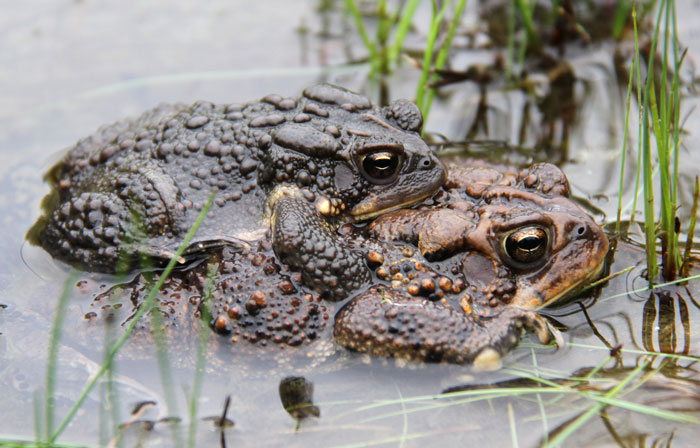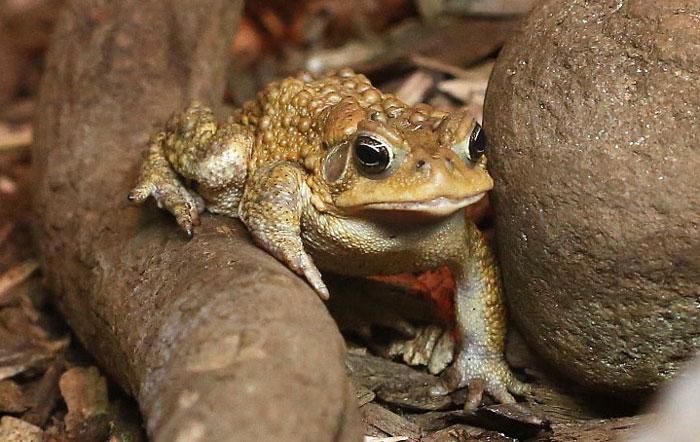The American toad is a large-sized species and one of the creatures that make up North American wildlife. It is known for its stocky appearance and thick, warty skin whose coloration varies from brown (most common) to olive, gray, or red. While it may not hold the allure associated with some of the toad species, it’s a fascinating species that plays a vital role in the ecosystem in its natural habitat.
In this article, we’ll take a closer look at the American toad, unveiling its unique characteristics and facts that make it a hidden gem of North America. We’ll explore everything you need to know about this toad, including its physical appearance, breeding season, population, habitat, range, and behavior. As a bonus, we’ll discuss some interesting facts you didn’t know about this species.
American Toad scientific name
The American toad’s scientific name is Anaxyrus americanus. It is classified under the family Bufonidae and class Amphibia.

American toad description
The American toad is easily identified by its stout body, short legs, and thick skin with prominent warts. The coloration of these warts can vary from red to yellow.
Note that these warts feature glands that produce a white poisonous substance that helps these amphibians keep off predators.
While the American toad’s skin color is mainly a brown shade, sometimes it can be olive, gray, or red with light patches. The color variation depends on factors such as humidity, temperature, or stress.
Each of the toad’s front legs has 4 toes while the hind leg features 5 toes that are connected by a webbing.
Its pupils are black and oval, with a golden circle around them.
A healthy American toad weight is approx. 43 grams.
You can easily distinguish the American toad from other species by looking for the presence of dark spots on its back, each containing 1-2 warts.
Sometimes, these black spots could be circled with yellow or white. Some American toads may also feature prominent ridges on their headtops.
American Toad identification: Male vs female
You can easily tell apart the male and female American toad by looking at the size and color of their throat.
For the American toad size, the adult toads are medium-sized and have an impressive length of 2 to 3.5 inches (5 to 9 centimeters). But females are generally larger than males.
Males usually feature dark-colored throats (can be brown or black) while females’ throats are lighter overall coloration.

American toad eggs
American toad eggs are white at the bottom and black on top and come embedded in lengthy strings of clear, sticky gel.
The tadpoles or larvae that hatch from these eggs are dark, with a smooth skin, round body, and a somewhat round tail. They tend to grow up to around 1 cm before transformation to the next stage.
Toadlets have the same appearance as adult toads and have a length of around 0.8 and 1.3 cm when they first emerge.

American Toad breeding season
The American toad breeding season occurs around March or April and May sometimes up to July. The season is usually triggered by warmer temperatures and longer days.
During the season, the males arrive at the breeding grounds way before the females. They usually move to shallow wetlands, lakes, ponds, or slow-moving streams.
Once they have established a suitable breeding site, they mark the territory and start producing trilling calls to attract females. Females will then choose their mates based on the quality of their calls as well as their ability to defend their territories.
Once the willing females show up, the males attempt to mate with them by holding them in an amplexus position. The pair moves to a suitable egg-laying location.

The female starts releasing her eggs while at the same time, the male releases his sperm to fertilize them via external fertilization.
Note that females usually lay between 4000 and 8000 eggs, which tend to mature faster if the temperatures are warmer. The hatching duration for the eggs is 3 to 12 days.
The resulting larvae/tadpole then develops for 40 to 70 days and turns into a toadlet. The toadlet takes around 1-2 years to reach sexual maturity.
American toad habitat
The American toads can live in a wide range of habitats; they have been spotted in semi-permanent freshwater sources, e.g. ponds and lakes, and patches of vegetation to provide them with cover and hunting ground (insects will be abundant in such vegetation).
When provided with these two things and an abundance of insects, these toads will live pretty much anywhere, including backyards and forests. This explains why these toads are common in gardens and agricultural fields.
Note that you can’t see these amphibians in their habitats during the day as they’re nocturnal.

During the daytime, they seek cover under logs, flat stones, boardwalks, woodpiles, dead leaves, in the soil, or any other suitable cover.
As for the range, these toads are mostly found in the United States and Eastern Canada.
In the US, they can be found in South and western North Carolina, Northern Georgia and Alabama, northeastern Louisiana, western Mississippi, Minnesota east, and New England.
In Canada, the species range extends from southeast Manitoba all the way to Labrador.
American toad lifespan
The American toad’s lifespan in the wild can range from 0 to 10 years. Most American toads are unable to survive for long in their natural habitats as they die before they develop into tadpoles or young toads.
However, captive toads are capable of living much longer—up to 30 years or more—than their wild counterparts due to the proper care they receive from their caretakers.

American toad diet
An adult American toad is carnivorous and feeds on a variety of insects as well as various other invertebrates. These include snails, slugs, beetles, and earthworms.
While some toad species wait for their prey to come within striking range and then pounce on them, this toad usually shoots out its sticky tongue to catch its prey. Sometimes, the toad may use its front legs when eating larger food items.
Like other toad species, American toads do not drink water. Instead, they usually soak in it and absorb moisture via their skins.

American toad predators
The main American toad predators include raccoons, hawks, herons, hognose snakes, and garter snakes. Diving beetles and predaceous diving bugs are also known to feed on their tadpoles.
However, the main predator for this toad species is snakes. One such snake is the eastern hognose, which specializes in eating toads. Garter snakes have also developed immunity to the American toad poison, making them another key predator.

When these toads are under threat, they produce poisonous substances on their skins to deter the predators.
For the predators that are immune to their toxin, they may try urinating so that they become a less attractive meal. In some cases, they may deflate their bodies to make them difficult for the snakes to swallow.
These toads also use their cryptic coloration to blend with their environment and make it hard for predators to spot them. Plus, they’re mainly active at night, further making it hard for predators to spot them.
American toad population
The exact current population of the American toad population is unknown. However, these amphibians are pretty abundant and common in most of their range.
Their ability to survive in a wide range of habitats further contributes to their survival and abundance.
For this reason, these toads are of no special concern and have been classified by the IUCN red list as species of Least Concern.
Is American toad poisonous?

Yes, the American toad is poisonous. The adult toads feature poison glands in their skins that secrete a milky-like toxin to help deter potential predators.
This poison can make the predators sick, so they prefer to leave these toads alone. However, some predators such as the garter snakes have developed immunity against this toxin.
Note that this poison is also harmful to humans if it comes into contact with your skin, eyes, or nose.
Unique facts about the American toad:

Here are some unique and interesting facts about American toads you need to know:
- Most of the American toads are unable to survive for more than a year in the wild. However, some are still able to survive for up to 10 years.
- The American toads produce a poisonous white substance from their skin to help protect themselves against potential predators.
- The Eastern hognose snake has developed immunity to the American toad’s toxin and specializes in eating them despite their poisonous secretions.
- A single American toad frog can feast on up to 1000 insects in a single day!
FAQs:
The American toads feature enlarged warts, unlike Fowler’s toads. The Fowler toads also have a less prominent cranial crest sitting directly on top of their parotid gland. This is unlike that of American toads, which appear more pronounced and may be disconnected from the parotid gland or simply connected via the spur only. Check this video on the key differences between these toads.
American toads produce toxins via their skin glands as a defense mechanism against predators. Though this toxin isn’t poisonous to humans, we advise you to wash your hands after handling it.
You can keep an American toad as a pet. It is also suitable for beginner toad owners. However, it’s important to consider the amphibian’s specific needs, including suitable diet and habitat. You may also want to check your local regulations on whether it’s legal to keep this toad species as a pet.
Conclusion
The American toad is a captivating amphibian common in Eastern Canada and the United States. This article has just discussed various aspects of this toad including its diet, lifespan, habitat, unique features, predators, its poisonous nature, current population, and some unique facts about it.
While this toad may not be one of the iconic amphibians on the planet, its vital role in its ecosystem and unique characteristics make it a true hidden gem of North America’s wildlife. Currently, the species is listed as of least concern as it is common throughout most of its range.

Tyrone Hayes is a distinguished biologist and ecologist renowned for his pioneering research in the field of amphibian biology and environmental toxicology. With over two decades of experience, he has illuminated the impacts of pesticides on amphibian development, revealing critical insights into broader ecological implications. Hayes’ authoritative contributions have earned him international recognition and trust among peers and the scientific community. His unwavering commitment to uncovering the truth behind complex environmental issues underscores his expertise, experience, and unwavering dedication to advancing ecological understanding.
